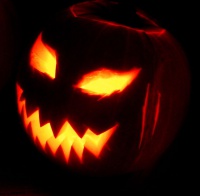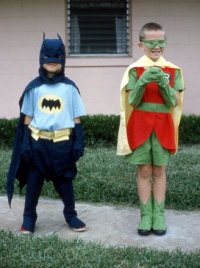Halloween
Halloween, 31 October, is a day in which candy is traditionally handed out to children. Halloween in recent years has become more of an adult oriented, secular celebration, which has been extensively embraced by the gay community. In 2010, Americans spent an estimated $800 million on costumes for children and $1 billion on costumes for adults. [1]
Halloween has never been particularly popular within the boylove community despite it's relationship to boys and the cultural crossover with the gay community. This is likely due to the myths that "pedophiles" kidnap and otherwise hurt children on Halloween, despite the fact that there is no documented proof of this ever occurring. Some states have used these myths to justify prohibiting those labeled as sex offenders, ranging from rapists of women to men caught urinating in an ally, from participating in Halloween related activities, including adding further restrictions on their freedoms and Human rights.[2]
According to Emily Horowitz, Associate professor of sociology, St. Francis College in Brooklyn, NY,
“ In North Carolina, a sheriff tells parents to check the online sex offender registry before allowing children to trick-or-treat. In Montana, a town offers a "trunk-or-treat" event where kids can get Halloween candy from trunks of cars in a parking lot to avoid potential danger. In New York, "Operation Halloween: Zero Tolerance" prohibits sex offenders from wearing masks or costumes or answering their doors on Halloween, and, as a parole source says, "There is certainly nothing more frightening than the thought of one of these men opening their door to innocent children." In Oklahoma, a city council is considering an ordinance forbidding sex offenders from decorating their homes or passing out candy on Halloween. In Orange, California, sex offenders can't answer their door or have outside lighting on Halloween, but an additional ordinance requiring window signs saying, "No candy or treats at this residence" was recently revoked after attorneys argued it was a form of cruel and unusual punishment. Why worry about sex offenders on Halloween? Research shows no evidence of increased child sex abuse on Halloween and no evidence that a child was ever a victim of sexual abuse by a stranger while out trick-or-treating. [3]
”
History and traditions

Halloween or Hallowe'en a contraction of "All Hallows' Evening"),[4] also known as Allhalloween,[5] All Hallows' Eve,[6] or All Saints' Eve,[7] is a yearly celebration observed in a number of countries on 31 October.
According to many scholars, All Hallows' Eve is a Christianized feast initially influenced by Celtic harvest festivals,[8] with possible pagan roots, particularly the Gaelic Samhain.[6][9][10] Other scholars maintain that it originated independently of Samhain and has solely Christian roots.[11]
Typical festive Halloween activities include trick-or-treating (or the related "guising"), attending costume parties, decorating, carving pumpkins into jack-o'-lanterns, lighting bonfires, apple bobbing, visiting haunted attractions, playing pranks, telling scary stories and watching horror films.[12]
Trick-or-treating

In the Pre-Christian era in Europe, it was believed that during Samhain, the veil between our world and the spirit world was thinnest, and that the ghosts of the deceased could mingle with the living. The historian Jack Santino says, "It was the biggest and most significant holiday of the Celtic year. The Celts believed that at the time of Samhain, more so than any other time of the year, the ghosts of the dead were able to mingle with the living, because at Samhain the souls of those who had died during the year traveled into the otherworld. People gathered to sacrifice animals, fruits, and vegetables. They also lit bonfires in honor of the dead, to aid them on their journey, and to keep them away from the living. On that day all manner of beings were abroad: ghosts, fairies, and demons--all part of the dark and dread."[13] The superstition was that the visiting ghosts could disguise themselves in human form, such as a beggar, and knock on your door during Samhain asking for money or food. If you turned them away empty-handed, you risked receiving the wrath of the spirit and being cursed or haunted.
Another Celtic myth was that dressing up as a ghoul would fool the evil spirits into thinking that you were one of them so that they would not try to take your soul. In the U.S., trick-or-treating became a customary Halloween tradition around the late 1950s, after it was brought over by Irish immigrants in the early 1900s.[14]
Jack-O'-Lantern
A jack-o'-lantern (or jack o'lantern) is a carved pumpkin, or turnip, and named after the phenomenon of strange light flickering over peat bogs, called will-o'-the-wisp or jack-o'-lantern. In a jack-o'-lantern, the top is cut off to form a lid and the inside flesh then scooped out; an image, usually a monstrous or comical face, is carved out of the pumpkin's rind to expose the hollow interior. To create the lantern effect, a light source (such as a candle or tea light) is placed within before the lid is closed. This is traditionally a flame or electric candle, though pumpkin lights featuring various colors and flickering effects are also marketed specifically for this purpose. It is common to see jack-o'-lanterns on doorsteps and otherwise used as decorations prior to and during Halloween.[15]
|
Jack's Lantern The origins of the Jack-O'-Lantern comes from an Irish folk legend about a man named Jack (AKA Stingy Jack) who was a cute young boy who took pleasure in playing tricks on just about everyone. One day, he tricked the Devil into climbing up an apple tree. After the Devil climbed up the tree, Stingy Jack hurriedly placed crosses around the trunk of the tree. Unable to touch a cross, the Devil was stuck in the tree. Stingy Jack made the Devil promise him not to take his soul when he died. Once the devil promised not to take his soul, Stingy Jack removed the crosses, and the Devil climbed down out of the apple tree. Later, when he died, he was also denied access to Heaven and was stuck wandering the Earth. He carved out a turnip and stuck a burning ember inside to ward off evil spirits. This became known as Jack's Lantern.[16] [17] |
When the Irish immigrants came to America in the mid-1800's, turnips were not commonly available and pumpkin were much easier to carve out.
References
- ↑ Halloween craze started in gay culture
- ↑ http://criminal.findlaw.com/criminal-charges/halloween-sex-offender-laws.html
- ↑ Manufacturing Fear: Halloween Laws for Sex Offenders
- ↑ Thomas Thomson, Charles Annandale (1896). A History of the Scottish People from the Earliest Times: From the Union of the kingdoms, 1706, to the present time. Blackie. http://books.google.com/books?id=YVgJAAAAIAAJ&q=Hallowe'en+contraction&dq=Hallowe'en+contraction&hl=en&ei=Y6i8TtXJOcargwe2lN28Bw&sa=X&oi=book_result&ct=result&resnum=5&ved=0CD8Q6AEwBDgK. Retrieved on 31 October 2011. "Of the stated rustic festivals peculiar to Scotland the most important was Hallowe'en, a contraction for All-hallow Evening, or the evening of All-Saints Day, the annual return of which was a season for joy and festivity."
- ↑ Palmer, Abram Smythe (1882). Folk-etymology. Johnson Reprint. p. 6.
- ↑ 6.0 6.1 Merriam-Webster's Encyclopædia of World Religions. Merriam-Webster. 1999. http://books.google.com/books?id=ZP_f9icf2roC&pg=PA408&dq=all+hallow's+eve+christian+origin&hl=en&ei=dUyvTrfhIYetgwen5YiCAg&sa=X&oi=book_result&ct=result&resnum=6&ved=0CE8Q6AEwBQ#v=onepage&q&f=false. Retrieved on 31 October 2011. "Halloween, also called All Hallows' Eve, holy or hallowed evening observed on October 31, the eve of All Saints' Day. The pre-Christian observances influenced the Christian festival of All Hallows' Eve, celebrated on the same date."
- ↑ NEDCO Producers' Guide. 31-33. Northeast Dairy Cooperative Federation. 1973. "Originally celebrated as the night before All Saints' Day, Christians chose November first to honor their many saints. The night before was called All Saints' Eve or hallowed eve meaning holy evening.".
- ↑ "Halloween." History.com. Retrieved 24 October 2013.
- ↑ Nicholas Rogers (2002). Halloween: From Pagan Ritual to Party Night. Oxford University Press. http://books.google.com/books?id=stWZ_UDteMIC&pg=PA22&dq=halloween+christian+holy+day&hl=en&ei=wCiwTu-tN8j00gGJ5bjGAQ&sa=X&oi=book_result&ct=result&resnum=9&ved=0CG8Q6AEwCA#v=onepage&q=halloween%20christian%20holy%20day&f=false. Retrieved on 31 October 2011. "Halloween and the Day of the Dead share a common origin in the Christian commemoration of the dead on All Saints' and All Souls' Day. But both are thought to embody strong pre-Christian beliefs. In the case of Halloween, the Celtic celebration of Samhain is critical to its pagan legacy, a claim that has been foregrounded in recent years by both new-age enthusiasts and the evangelical Right."
- ↑ Austrian information. 1965. http://books.google.com/books?id=9FU7AQAAIAAJ&q=all+hallow's+eve+wear+masks+Christian+souls+vengeance&dq=all+hallow's+eve+wear+masks+Christian+souls+vengeance&hl=en&ei=u1CvTtjjFOKHsAKEudDkAQ&sa=X&oi=book_result&ct=result&resnum=1&ved=0CC0Q6AEwAA. Retrieved on 31 October 2011. "The feasts of Hallowe'en, or All Hallows Eve and the devotions to the dead on All Saints' and All Souls' Day are both mixtures of old Celtic, Druid and other pagan customs intertwined with Christian practice."
- ↑ Rogers, Nicholas (2003). Halloween: From Pagan Ritual to Party Night. Oxford University Press. p. 22. ISBN 9780195168969. "Festivals commemorating the saints as opposed to the original Christian martyrs appear to have been observed by 800. In England and Germany, this celebration took place on 1st November. In Ireland, it was commemorated on 20th April, a chronology that contradicts the widely held view that the November date was chosen to Christianize the festival of Samhain."
- ↑ Halloween From Wikipedia
- ↑ Halloween: The Fantasy and Folklore of All Hallows by Jack Santino
- ↑ http://www.livescience.com/16677-halloween-superstitions-traditions.html Kids Trick-Or-Treating in Costumes Trick-Or-Treating in Costumes
- ↑ Jack-o'-lantern from Wikipedia
- ↑ Irish Origins: Legend of Jack
- ↑ Jack O'Lanterns and The Tale Of Stingy Jack